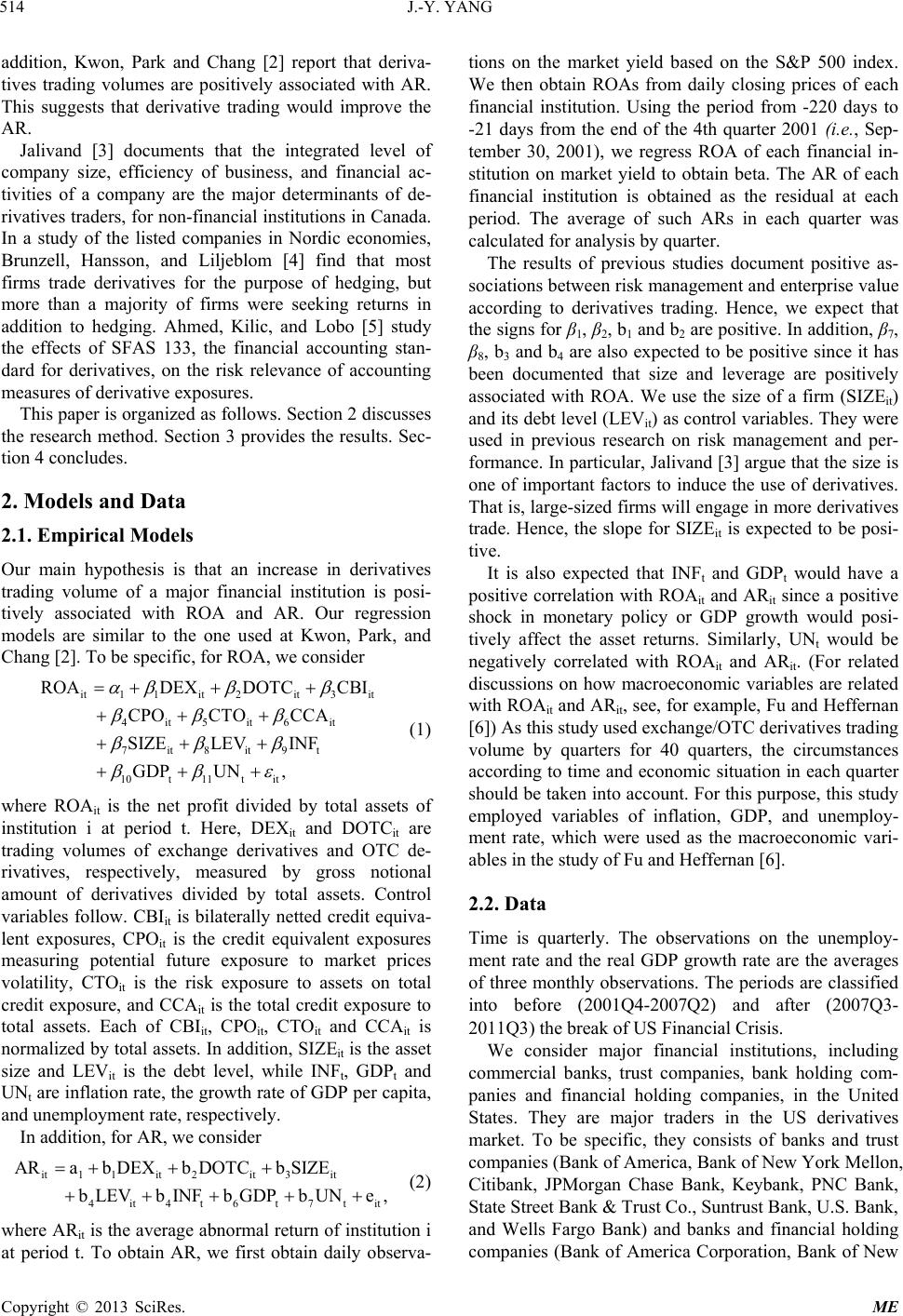
J.-Y. YANG
514
addition, Kwon, Park and Chang [2] report that deriva-
tives trading volumes are positively associated with AR.
This suggests that derivative trading would improve the
AR.
Jalivand [3] documents that the integrated level of
company size, efficiency of business, and financial ac-
tivities of a company are the major determinants of de-
rivatives traders, for non-financial institutions in Canada.
In a study of the listed companies in Nordic economies,
Brunzell, Hansson, and Liljeblom [4] find that most
firms trade derivatives for the purpose of hedging, but
more than a majority of firms were seeking returns in
addition to hedging. Ahmed, Kilic, and Lobo [5] study
the effects of SFAS 133, the financial accounting stan-
dard for derivatives, on the risk relevance of accounting
measures of derivative exposures.
This paper is organized as follows. Section 2 discusses
the research method. Section 3 provides the results. Sec-
tion 4 concludes.
2. Models and Data
2.1. Empirical Models
Our main hypothesis is that an increase in derivatives
trading volume of a major financial institution is posi-
tively associated with ROA and AR. Our regression
models are similar to the one used at Kwon, Park, and
Chang [2]. To be specific, for ROA, we consider
it1 1it2it3it
4it5it6 it
7it8it9t
10t11 t it
ROADEXDOTC CBI
CPO CTO CCA
SIZELEV INF
GDPUN ,
(1)
where ROAit is the net profit divided by total assets of
institution i at period t. Here, DEXit and DOTCit are
trading volumes of exchange derivatives and OTC de-
rivatives, respectively, measured by gross notional
amount of derivatives divided by total assets. Control
variables follow. CBIit is bilaterally netted credit equiva-
lent exposures, CPOit is the credit equivalent exposures
measuring potential future exposure to market prices
volatility, CTOit is the risk exposure to assets on total
credit exposure, and CCAit is the total credit exposure to
total assets. Each of CBIit, CPOit, CTOit and CCAit is
normalized by total assets. In addition, SIZEit is the asset
size and LEVit is the debt level, while INFt, GDPt and
UNt are inflation rate, the growth rate of GDP per capita,
and unemployment rate, respectively.
In addition, for AR, we consider
it1 1it2it3it
4 it4t6t7tit
ARab DEXbDOTCb SIZE
LEVb INFb GDPbUNe,
(2)
where ARit is the average abnormal return of institution i
at period t. To obtain AR, we first obtain daily observa-
tions on the market yield based on the S&P 500 index.
We then obtain ROAs from daily closing prices of each
financial institution. Using the period from -220 days to
-21 days from the end of the 4th quarter 2001 (i.e., Sep-
tember 30, 2001), we regress ROA of each financial in-
stitution on market yield to obtain beta. The AR of each
financial institution is obtained as the residual at each
period. The average of such ARs in each quarter was
calculated for analysis by quarter.
The results of previous studies document positive as-
sociations between risk management and enterprise value
according to derivatives trading. Hence, we expect that
the signs for β1, β2, b1 and b2 are positive. In addition, β7,
β8, b3 and b4 are also expected to be positive since it has
been documented that size and leverage are positively
associated with ROA. We use the size of a firm (SIZEit)
and its debt level (LEVit) as control variables. They were
used in previous research on risk management and per-
formance. In particular, Jalivand [3] argue that the size is
one of important factors to induce the use of derivatives.
That is, large-sized firms will engage in more derivatives
trade. Hence, the slope for SIZEit is expected to be posi-
tive.
It is also expected that INFt and GDPt would have a
positive correlation with ROAit and ARit since a positive
shock in monetary policy or GDP growth would posi-
tively affect the asset returns. Similarly, UNt would be
negatively correlated with ROAit and ARit. (For related
discussions on how macroeconomic variables are related
with ROAit and ARit, see, for example, Fu and Heffernan
[6]) As this study used exchange/OTC derivatives trading
volume by quarters for 40 quarters, the circumstances
according to time and economic situation in each quarter
should be taken into account. For this purpose, this study
employed variables of inflation, GDP, and unemploy-
ment rate, which were used as the macroeconomic vari-
ables in the study of Fu and Heffernan [6].
2.2. Data
Time is quarterly. The observations on the unemploy-
ment rate and the real GDP growth rate are the averages
of three monthly observations. The periods are classified
into before (2001Q4-2007Q2) and after (2007Q3-
2011Q3) the break of US Financial Crisis.
We consider major financial institutions, including
commercial banks, trust companies, bank holding com-
panies and financial holding companies, in the United
States. They are major traders in the US derivatives
market. To be specific, they consists of banks and trust
companies (Bank of America, Bank of New York Mellon,
Citibank, JPMorgan Chase Bank, Keybank, PNC Bank,
State Street Bank & Trust Co., Suntrust Bank, U.S. Bank,
and Wells Fargo Bank) and banks and financial holding
companies (Bank of America Corporation, Bank of New
Copyright © 2013 SciRes. ME